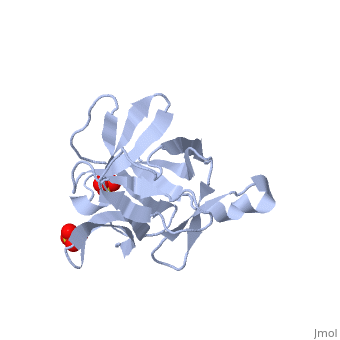Interleukin
From Proteopedia
FunctionInterleukin (IL) is a cytokine which functions in the immune system. IL families are denoted by numbers[1].
See also Growth factors RelevanceUncontrolled activation of IL-1 is a component of of some inflammatory diseases including gout[2]. DiseaseIL deficiency results in autoimmune disease[7]. 3D structures of interleukin
|
| |||||||||||
References
- ↑ Dinarello CA. Biology of interleukin 1. FASEB J. 1988 Feb;2(2):108-15. PMID:3277884
- ↑ Schett G, Dayer JM, Manger B. Interleukin-1 function and role in rheumatic disease. Nat Rev Rheumatol. 2016 Jan;12(1):14-24. doi: 10.1038/nrrheum.2016.166. Epub 2015, Dec 10. PMID:26656658 doi:http://dx.doi.org/10.1038/nrrheum.2016.166
- ↑ Pease JE, Sabroe I. The role of interleukin-8 and its receptors in inflammatory lung disease: implications for therapy. Am J Respir Med. 2002;1(1):19-25. PMID:14720072
- ↑ Shah N, Kammermeier J, Elawad M, Glocker EO. Interleukin-10 and interleukin-10-receptor defects in inflammatory bowel disease. Curr Allergy Asthma Rep. 2012 Oct;12(5):373-9. doi: 10.1007/s11882-012-0286-z. PMID:22890722 doi:http://dx.doi.org/10.1007/s11882-012-0286-z
- ↑ Iyer SS, Cheng G. Role of interleukin 10 transcriptional regulation in inflammation and autoimmune disease. Crit Rev Immunol. 2012;32(1):23-63. PMID:22428854
- ↑ Eken A, Singh AK, Oukka M. Interleukin 23 in Crohn's disease. Inflamm Bowel Dis. 2014 Mar;20(3):587-95. doi:, 10.1097/01.MIB.0000442014.52661.20. PMID:24481050 doi:http://dx.doi.org/10.1097/01.MIB.0000442014.52661.20
- ↑ Aksentijevich I, Masters SL, Ferguson PJ, Dancey P, Frenkel J, van Royen-Kerkhoff A, Laxer R, Tedgard U, Cowen EW, Pham TH, Booty M, Estes JD, Sandler NG, Plass N, Stone DL, Turner ML, Hill S, Butman JA, Schneider R, Babyn P, El-Shanti HI, Pope E, Barron K, Bing X, Laurence A, Lee CC, Chapelle D, Clarke GI, Ohson K, Nicholson M, Gadina M, Yang B, Korman BD, Gregersen PK, van Hagen PM, Hak AE, Huizing M, Rahman P, Douek DC, Remmers EF, Kastner DL, Goldbach-Mansky R. An autoinflammatory disease with deficiency of the interleukin-1-receptor antagonist. N Engl J Med. 2009 Jun 4;360(23):2426-37. doi: 10.1056/NEJMoa0807865. PMID:19494218 doi:10.1056/NEJMoa0807865

